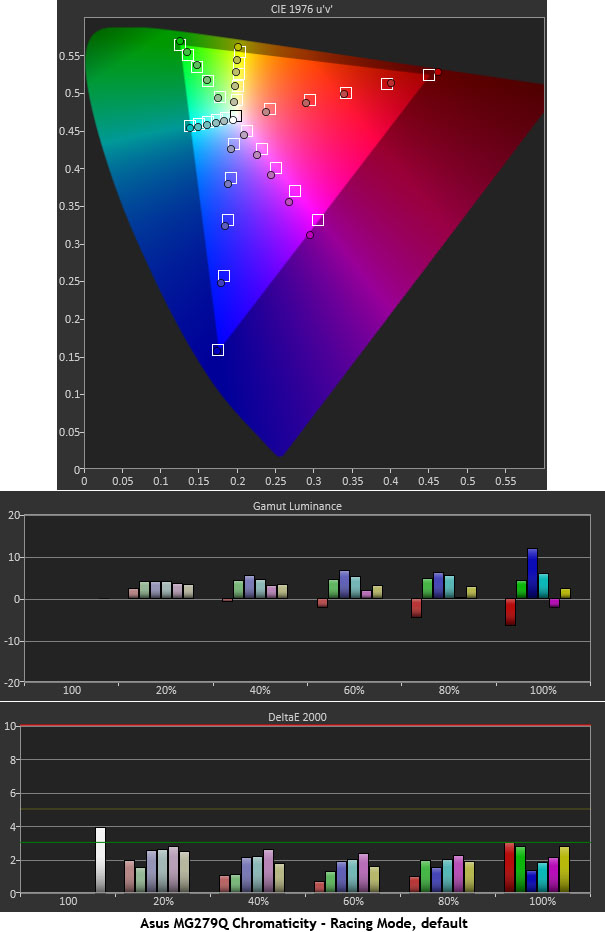Asus MG279Q 27-Inch FreeSync Monitor Review
Today we're reviewing Asus' MG279Q FreeSync gaming monitor, looking at how well it compares to Acer's XB270HU IPS G-Sync monitor?
Why you can trust Tom's Hardware
Color Gamut And Performance
For details on our color gamut testing and volume calculations, please click here.
The color gamut and luminance values in Racing mode are pretty much on target by default. The only issues we can see is a hue error in magenta and a blue luminance result that's too high at 100 percent saturation. These are extremely minor anomalies. All the Delta E results are below three and the average is an invisible 2.06dE.
Switching to sRGB mode improves the magenta secondary and brings luminance a little more in line, but there are some slight saturation errors in red that increase the average error to 2.8dE. Color accuracy in this mode is decent but given its greenish white balance and lack of adjustability, we'd stick with the Racing mode for all applications.
A grayscale calibration in Racing mode fixes the magenta hue issue and returns the luminance values to their targets. The average error is now a low 1.33dE.
Now we return to the comparison group.
Believe it or not, this isn't the most accurate gaming monitor we've tested, although it's so close, we'll call the top four screen results a wash. It's interesting to note that the top finisher is a TN screen. IPS is reputed to have better color but our tests say otherwise.
Gamut Volume: Adobe RGB 1998 And sRGB
AU Optronics' new IPS 144Hz panel seems to come with a little bonus in the red primary. That's the main reason for its over 100 percent gamut volume result. This doesn't really matter in a gaming monitor comparison, but some photographers might benefit from the additional volume if they're willing to calibrate the rest of their production chain.
Get Tom's Hardware's best news and in-depth reviews, straight to your inbox.
Current page: Color Gamut And Performance
Prev Page Grayscale Tracking And Gamma Response Next Page Viewing Angles, Uniformity, Response, Lag And FreeSync
Christian Eberle is a Contributing Editor for Tom's Hardware US. He's a veteran reviewer of A/V equipment, specializing in monitors. Christian began his obsession with tech when he built his first PC in 1991, a 286 running DOS 3.0 at a blazing 12MHz. In 2006, he undertook training from the Imaging Science Foundation in video calibration and testing and thus started a passion for precise imaging that persists to this day. He is also a professional musician with a degree from the New England Conservatory as a classical bassoonist which he used to good effect as a performer with the West Point Army Band from 1987 to 2013. He enjoys watching movies and listening to high-end audio in his custom-built home theater and can be seen riding trails near his home on a race-ready ICE VTX recumbent trike. Christian enjoys the endless summer in Florida where he lives with his wife and Chihuahua and plays with orchestras around the state.




